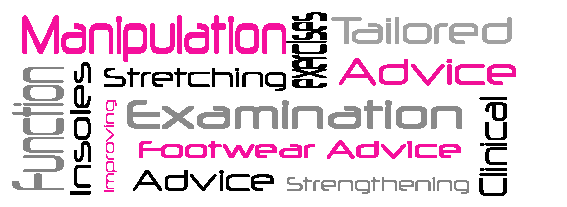
Conservative management services of musculoskeletal disease and injury of the foot and ankle is not supported as it should be in the NHS. The speciality of musculoskeletal podiatry is often very constrained by pressures on the service and budget. It is far better accessed privately and provided by clinicians who have specialist knowledge and demonstrable experience and further qualifications in the field.
Musculoskeletal Podiatry is...
the assessment, diagnosis and treatment of biomechanical conditions primarily affecting the lower limbs. Such conditions may lead to acute or longer-term problems.
|
|
|
Biomechanics is...
The
study of how biological materials behave under stress and strain.
Podiatry practises the clinical application of this knowledge and
understanding. Clinically podiatrists look at the movements of
your foot and how it compensates for poor alignment and function
as it contacts with the ground. foot
dysfunction can also affect the rest of your lower limb and leads
to aches and pains in your feet and other areas of your body –
such as your knees, hips and back. Long-term
biomechanical injuries occur when there is excessive movement and
force placed upon joints and/or soft tissue structures, may also
be referred to as overuse injuries.
The
foot
is unique in the body due to its position and function. The foot
has to transfer forces greater than body weight to the ground to
allow us to walk, and because of the number of steps we take each
day any inefficiency in foot function is multiplied many times
over. Sporting activities such as running and many sports involve
forces much greater than this. The
foot has to compensate for poor function or posture higher up the
body, causing abnormal motions in the foot and ankle. These
compensations can result in over strains and injuries. Equally
foot dysfunction can cause other joints of the spine, pelvis, hip
and knee to work in poor alignment creating pathologies within
these other joints as well as in the foot
A
detailed ‘biomechanical’ examination attempts to pick out these
minor imbalances and seeks to correct them by mechanical means.
Musculoskeletal
(MSK)
Podiatrists should be the first health professional you should
approach if you have activity related foot pain. They are trained
to identify the cause and potential origins of lower limb
dysfunction to resolve a multitude of conditions that can make
being on your feet, or taking part in any sport uncomfortable.
Conditions such as Plantar Fasciitis, Metatarsalgia, Arch pain,
Tibialis Posterior Dysfunction and Achilles Tendinopathy are
regularly managed by MSK Podiatrists.
Treatment

Treatment
can
often involve the use of insoles to realign, cushion or offload
structures. A foot orthosis works by increasing the efficiency
with which the foot functions. This altered function can affect
the whole lower limb, pelvis and back thus improving the body’s
general posture and ability to function.
Treatment
can
involve manipulation, which involves short sharp joint thrusts,
muscle and tissue stretches, and pressure and massage techniques.
Manipulation can often produce a 'cracking' or 'popping' noise
which is just the joint fluid expanding into the space released by
treatment.
Stretching
and
strengthening exercises are often essential to correct or overcome
dysfunction.